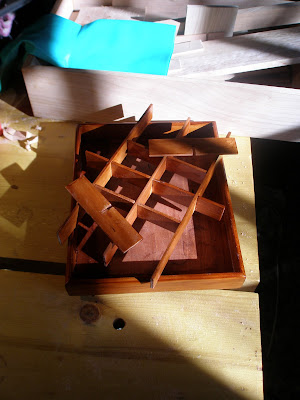I asked my mom to do a little guest-blogging because she made us the most incredible oven mitts ever for Christmas. (that sounds a little funny. best. oven. mitts. EVER. But it's true. Trust me.) So without further ado, here's the super-talented marmee:

I decided on a trip to visit the girls in July that I’d try to make Christmas gifts this year, and at the same time try to learn to machine quilt.
I’d bought Harriet Hargrave’s Heirloom Machine Quilting and had read it, but I’d never dropped the feed dog on my machine or done anything with a darning foot before.
So I thought I would try stitching around the designs on fabric first to see if I could learn in baby steps. Tracing was always a big save for me in art projects – I can copy almost anything!
Julie gave me some charming retro kitchen fabric that she’d been saving in her stash, and we picked out a gold cotton for binding. [The cool retro print was purchased from Superbuzzy. Looks like they're out of the blue, but still have it in light brown.]
The first issue was what batting to use. Julie said she’d seen a reference to insulated batting on some of the blogs she reads, so I dived into Google and came up with Insulbright. I used two thicknesses of cotton quilt batting (I bought a crib bat) and then one layer of Insulbright, and used a cotton duck that matched the background for the reverse. It was quite a sandwich.

I started sewing on the motifs at the center, working out toward the edges. As my book had suggested, I tried using my fingertips on both sides of the fabric to guide the fabric under the needle to “trace” the design with the sewing machine. At first I went through a ton of thread and made tiny, tiny stitches, but as I continued I was able to push the material faster and gain more confidence that I wasn’t going to fail to follow the pattern.
I also cheated (I am old enough to be entitled to cheat, I’ll have you know) because I used a Daylight lamp with a 5-inch diopter magnifying lens, which I shoved right in front of the needle. It made it a lot easier to see what I was doing.
It took a lot of time, but I find any kind of repetitive work like this soothing. We turned up the Big Band/Swing on the house stereo system, and I sat there and quilted. Is it because it’s sort of meditative? I don’t know – but I get a lot of thinking done when I do stuff like this.
Plus I really liked the way it turned out.
Then it was time to do gifts for everybody else in the family.

For my sister and sister-in-law, I used Moda quilting fabrics – I love the prints and the feel of the fabric. My sis has an elegant Provencal kitchen, so I used this brown paisley print with a smaller companion print on the back, and a third print for the binding. I also made a set for my sister-in-law, using some complementing Moda prints in blue.
Now to make some mitts and potholders for me! I’m my toughest client, that’s for sure, and I’ve been looking for something in blue and natural that will go with the Silestone countertops I got last Christmas. I think Julie found me the right fabric, though – this new Williamsburg quilt fabric she saw at PurlSoho’s website. I’ve never been big on birds, but I think I can center my design to focus on the flowers, not the birds. If my local quilt shop ever gets the blue back in stock, that is.
In the meantime, the girls gave me a wonderful gift: a machine quilting class, with them, in February. Something to look forward to, for sure!
From Julie: The mitts really are amazing. They are perfect in my tiny kitchen. And they are just so perfectly detailed. Now you know where my perfectionism comes from...it runs a bit rampant in our family!

Mama, you forgot to mention the great dishtowels you made to match! Yes, that's right. I have matching homemade dishtowel oven-door hangy things. Mom bought a single handtowel, cut it in half, and attached tops and tabs to them. Love.
Thanks mama for blogging!! xo











